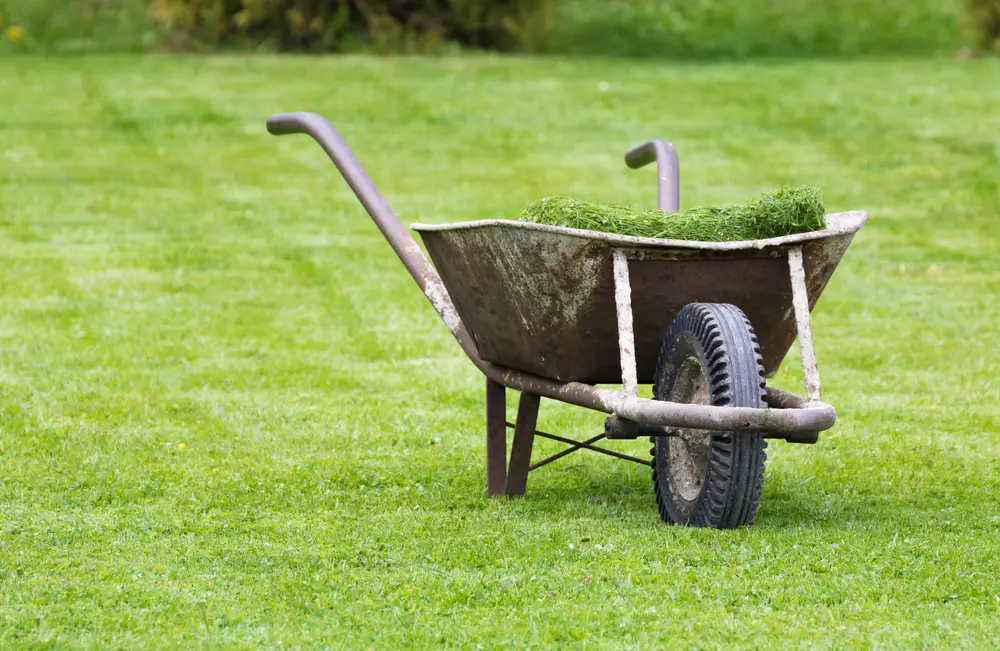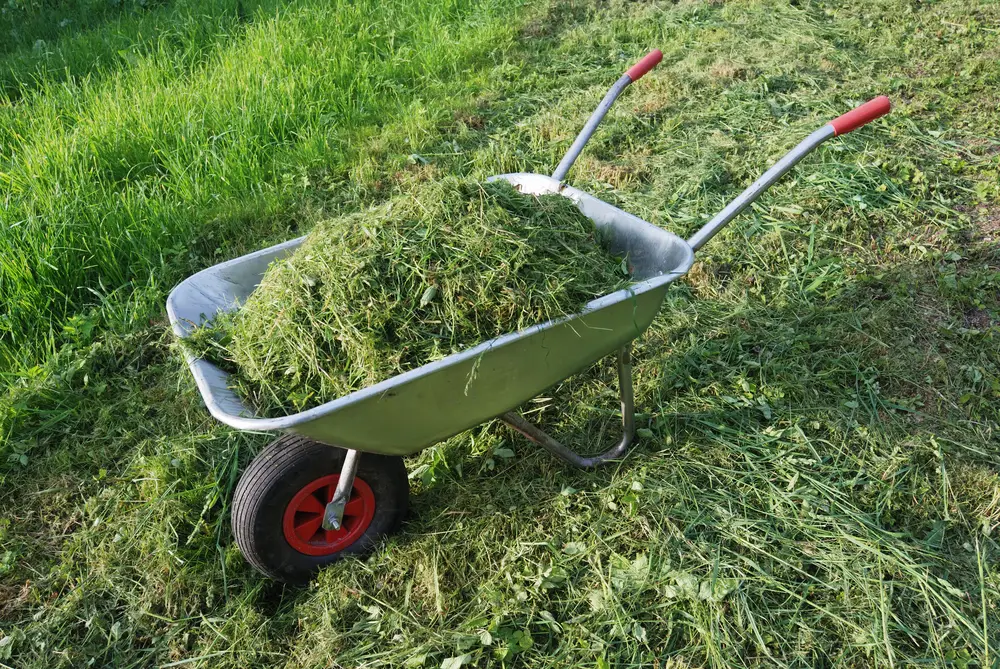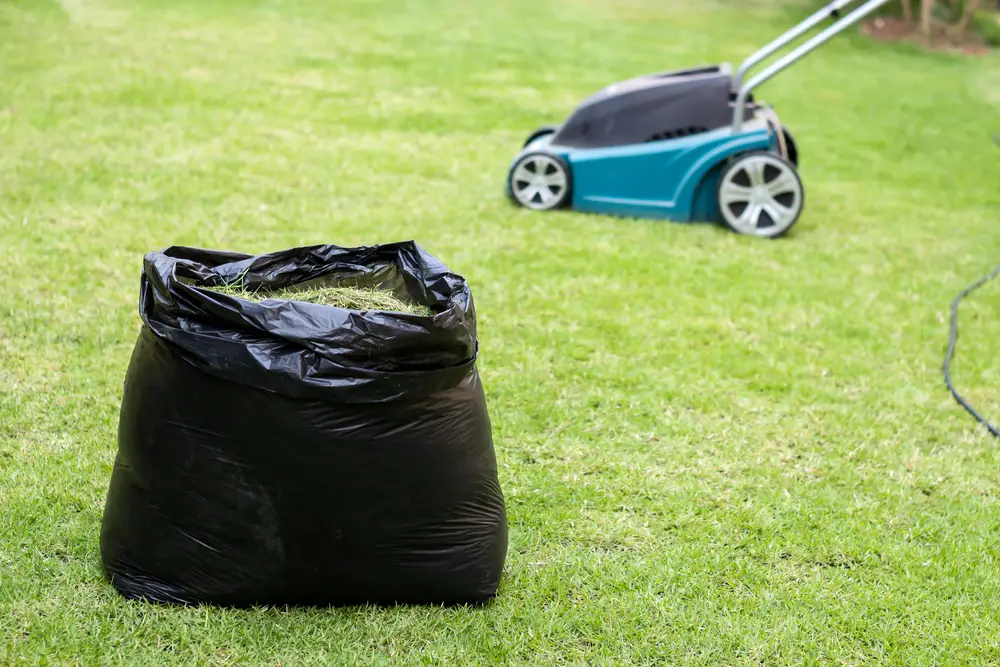In this content you’ll learn:
Key Takeaways
- You can do many things with grass clippings, such as leaving them on your lawn, mulching them, turning them into liquid fertilizer, and using them as a garden layer.
- Grass clippings are 80% water and contain 4% nitrogen, making them beneficial for plants.
- You can collect grass clippings by hand, with a grass bagger, or lawn sweeper.
So, you’ve got a bunch of grass clippings left behind after you finish mowing. Maybe you’re wondering how to use them. To help, here’s what to do with grass clippings when you finish mowing!
What To Do With Grass Clippings When You’re Done Mowing

You can use grass clippings to improve your lawn and garden in many ways!
Let’s start with leaving them on your lawn.
Leave Them On Your Lawn
If you leave your grass clippings on your lawn, they can act as natural mulch. Grass contains about 4% nitrogen, which becomes available to your lawn as the grass clippings decompose. Nitrogen promotes many vital processes in grass, so using grass clippings this way is excellent.
Grass is also 80% water, so leaving grass clippings on your lawn provides it with some hydration.
While mowing, if your lawn mower clumps your grass clippings, you’ll want to rake them out evenly so they can dry properly. Usually, this isn’t a problem if you follow the one-third rule (only mowing one-third of your grass’s total height at a time).
Turn Them Into A Liquid Fertilizer
Using fresh grass clippings to make a liquid fertilizer is an easy and cheap way to increase the health of your garden. Plants prefer liquid fertilizer since they absorb it faster than other types.
To make liquid fertilizer from fresh grass clippings, follow these steps:
- Use a garden bucket (about five gallons)
- Fill your bucket two-thirds full of fresh grass clippings
- Fill the bucket with as much water as you can
- Let this mixture sit to ferment for 3-4 days in a partially shaded and warm area
- OPTIONAL: Use a netting or mesh fabric to cover the bucket opening to keep bugs out. Just ensure the covering is breathable to allow the gas the fermentation process creates to escape.
- After 3-4 days, strain out the grass clippings
- Pour ½ – 1 whole cup into the soil of each plant to ensure all nutrients are sent directly to the roots for proper absorption
Use Them As Organic Mulch For Your Soil
Grass clippings are a nutrient-dense mulch source for your garden as much as for your lawn!
You can take advantage of this by mixing the clippings into the soil. Grass clippings’ light weight also helps keep the soil breathable so oxygen can reach roots.
To make this mulch, first, let the clippings dry for 24 hours. Letting them dry prevents clumping from dampness.
Once dry, fluff the clippings to separate the grass blades and spread them evenly atop your garden soil at a ½ – 1-inch thickness. Then mix the clippings in.
The amount of clippings you use depends on your garden size, but adding more than the above depth can lead to excess water retention and fungal disease.
Turn Them Into A Garden Top Dressing
Using grass clippings as a top dressing (or top layer) helps suppress weeds, retain moisture, and manage soil temperatures on hotter days.
Like the mulch option, dry your clippings for 24 hours to avoid clumping. After, spread a layer of clippings, about ½ to 1 inch thick, across the top of your garden. Spreading them this way prevents sunlight from reaching weeds below your garden plants. Your plants will be okay since they’ll be above the clippings.
The clippings will also reduce the soil temperature to a more comfortable one for your plants, especially on hot summer days when they would otherwise wilt due to the heat.
Use Them In Raised Garden Bed Layering (Lasagna Gardening)
This raised garden bed technique (“lasagna gardening”) requires layering compostable materials, such as paper, cardboard, leaves, grass clippings, and other similar materials below the 6-12 inch topsoil layer you plant in. These lower layers provide a direct and large amount of nutrients as they decompose over time into nutrient-rich soil.
Stack these materials in one-inch-deep layers, alternating from green to brown compostables. Repeat the layers of your choosing at least twice each. Finally, add your 6-12 inches of topsoil to be able to plant right away, and that’s it!
However, please note that to properly layer these materials, you will require some knowledge of green (nitrogen-rich) and brown (carbon-rich) compostable materials (which you’ll find more information about below).
Use Them In Compost
Proper composting requires green materials (nitrogen-rich) and brown materials (carbon-rich). Grass clippings fall under the “green” material category!
Green materials are wet, quick to decompose and provide nitrogen as they break down. These include food scraps, grass clippings, and manure. Green materials also create small amounts of heat during decomposition. These factors create the perfect environment for the microorganisms that help break down the compost pile.
Brown materials are dry, decompose slowly, and provide carbon to the organisms breaking down the compost pile. These include brown leaves, straw, shredded paper, sawdust, and woodchips.
The ratio I recommend you follow for greens to browns is one part greens to three to four parts browns. You don’t have to be perfectly accurate, but this is a good guideline.
However, if the compost pile is not heating up (taking too long to break down), you may need to add more greens.
If the pile is starting to stink, add more browns.
Turning your compost pile will also help properly distribute heat and break down the pile.
Give Them To Your Pets
Grass clippings, once dried thoroughly for about 2-3 days (turning a nice golden color), make a great bedding option for your birds, rabbits, gerbils, and mice. You can also feed dried clippings to rabbits, gerbils, and mice as a treat or secondary food source and a great source of vitamins.
However, before feeding, you must make sure of the following:
- The clippings have never been treated with chemicals, which can poison your pet.
- Be sure the clippings are completely dried out, as fresh clippings can ferment in the animal’s stomach, resulting in severe gut issues.
It’s for the above reasons we recommend taking extra care when using grass clippings with your pets. Using other pet-safe materials avoids the above issues entirely.
Dispose Of Them Responsibly
Maybe you don’t want to use grass clippings, and that’s okay! Instead, research your local regulations for how you can dispose of them.
For instance, your area may have a program you can take advantage of. This can require the use of compostable paper bags workers will pick up.
How to Gather Grass Clippings

How you choose to gather your grass clippings is up to you. The good news is you have several options to choose from.
Let’s start with hand-gathering.
Hand-Gathering
Hand-gathering your clippings is your cheapest option!
You’ll need the following if you go this route:
- Plastic fan rake (these cover large areas and cause minimal lawn damage)
- Wheelbarrow
- Gardening gloves to protect against debris, insect bites, and diseased lawns (men, women)
- Compostable bags (if disposing of them)
After mowing, rake all your clippings into piles. Pick them up (making sure you’re wearing your gloves) and dump them into your wheelbarrow. If you’re disposing of them, transfer them to the compostable bags.
Lawn Sweepers
Lawn sweepers are smart additions to your lawn maintenance tool collection. They are a bit more expensive, but these devices pick up all kinds of lawn debris. You can buy them as standalone options or as a rear attachment for your ride-on lawn mower.
Using one of these will cut your grass clipping collection time way down.
Grass Baggers/Catchers
Grass baggers/catchers are a convenient way to collect grass clippings as you mow! They attach to your lawn mower in different ways, depending on what type of lawn mower you have.
For example, walk-behind baggers attach to the lawn mower’s rear door.
Riding lawn mowers, on the other hand, utilize entire systems, the most popular of which are the double/triple bagging systems. The storage bags mount behind the lawn mower, fed by a collection chute to the side.
Should You Gather Grass Clippings?
It’s usually a good idea to collect grass clippings. But should you always gather them?
No. Finding a good balance between bagging and leaving the clippings on your lawn is better.
I recommend leaving clippings on your lawn every 2-3 weeks if you mow weekly. This allows your lawn to access the clippings’ nutrients periodically while still allowing you to keep your lawn looking tidy the rest of the time.
